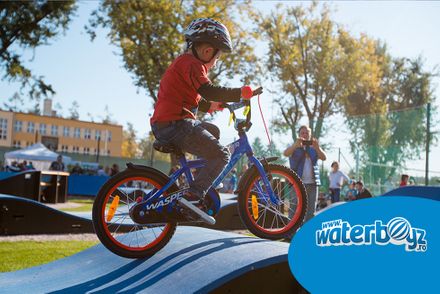Creating a skatepark is a complex process, but one that can offer a multitude of benefits for the community in which such a space operates. Today, we'll delve into the topic of skatepark design, examining the key prefabricated structures that can be successfully integrated into such a location, as well as how these elements can work together to create pathways of varying difficulty levels.
Identifying an experienced partner is a wise choice. A developer specialized in this niche can offer the necessary support in all important stages of such a project. Discover the benefits offered by a skatepark and how this place should be designed:
Table of Contents:
1. Advantages of a Skatepark
2. Essential Criteria in the Concept Phase
3. Designing a Skatepark
1. Advantages of a Skatepark
A skatepark represents a space of fun for the new generations. A specially designed setting with specific elements can generate numerous benefits for those who ride BMX bikes, rollerblades, skateboards, or scooters. Moreover, it contributes to improving the perception of the area where it's located.
1.1. Safe Space for Extreme Sports
A skatepark constructed according to current standards offers everyone the opportunity to perform tricks in complete safety. Far from road traffic or pedestrian areas, where numerous unpleasant incidents can occur, this location inspires confidence and creativity.
Integrating specific prefabricated structures into a space designed for extreme sports is regulated according to EN14974/2006+A1/2010. The quality of materials and how the elements in the skatepark work together are essential safety factors that can contribute to minimizing the risk of accidents.
Of course, the safety of those engaging in extreme sports is also ensured by specific protective gear (helmets, knee pads, elbow pads), as well as the experience they have in using certain elements in the specially designed area.
1.2. Contributes to Revitalizing the Area
Developing a skatepark can contribute to increased interest from young people in the respective area. This factor can over time lead to increased commercial potential for the area.
Around this outdoor play area, numerous other businesses can develop, such as Hospitality locations, equipment rental centers, VR simulator rooms, mini golf courses, and many other leisure spaces.
New transportation routes can be established to this location, public lighting in the area can see significant improvements, and the overall image can take on a fresher look, aligned with the role of a skatepark for a community of young people.
1.3. Environment for Socializing and Learning
In a properly designed skatepark, young people can join a strong social group built around a shared passion for extreme sports. Socializing based on a common interest is an essential element for the development of interpersonal skills in children and adolescents, which is important not only in this space for fun but also in everyday life.
Children can learn new tricks from each other, learn from a young age the principles of using a common facility, and participate in organized competitions in this place, overcoming their own mental and physical barriers. This is how a skatepark can mean more than just an urban space dedicated to extreme sports, playing a vital role in socialization and learning.
2. Essential Criteria in the Concept Phase
The design of a skatepark can differ from one project to another based on criteria such as:
- Available budget
- Access to European funds for this business
- Time required for project completion
- Purpose: recreational, training, competitions
- Level of difficulty of the routes
- Location: indoor or outdoor space
- Community interest in this location
- Available area and capacity
- Available products and their integration into the space
- Tourism potential of the area where it's located
If the development of a skatepark is based on business objectives, recurring costs for its optimal operation should also be considered: electricity, rent, water supply, maintenance services, salaries, supplies (if you're also setting up a HoReCa space in the area), security company contract.
Therefore, the development of a skatepark project involves elements of business, logistics, landscaping, legislation, all crucial for the functionality of the entire ensemble. Hence, it's essential to understand the importance of a partner with experience in designing play areas, so that all implementation costs fit within the established budget.
3. Designing a Skatepark
The structural elements for designing a skatepark comprise an extensive list of products that must be chosen to allow users freedom of movement based on their experience. Therefore, we can talk about creating two different areas within the same perimeter.
3.1. High Difficulty Zone
Dedicated to those experienced in skateboarding or BMX tricks, this section of the skatepark includes modular structures with level differences of 2-3 meters from the ground and inclined tracks that allow for speed launches to the next areas in a specific route.
Launch Ramps
Ideally, launch ramps are placed at one end of the perimeter so that riders can use the speed gained while descending on the secondary portions of the route. They are compatible with pump tracks, flat banks, and other freestyle elements. They can also be combined with other launch ramps in the same structure to create an impressive quarter pipe where space allows. They come in different sizes and shapes, so they can also be placed in the skatepark area dedicated to those with less experience.
Grind Rails
These are designed especially for those who can easily perform "boardslides" and "grinds." These elements can be combined with steps, sloped elements, or modular structures set vertically. The curved ends of the rails are designed for user safety. The length of a grind rail can vary; the most common sizes are 4m, 6m, and 8m. Additionally, the thickness of the rail can significantly differ from one model to another, depending on the difficulty level. The ideal material for creating this is galvanized stainless steel, resistant to multiple shocks.
Half Pipes
The famous half pipes are among the most challenging structures in a skatepark, but they allow for a large number of tricks in mid-air. Depending on the competitive level associated with the respective skatepark, these elements can vary in height, length, and width. A half pipe combines the central elements of the first two modular structures mentioned above:
- Launch ramp: necessary for achieving the ideal speed for performing tricks at a height.
- Grind rail: used for freestyle tricks involving sliding.
3.2. Low Difficulty Zone
For those without experience in using skatepark elements but who want to learn and progress in gaining control over them, here are two suitable structures:
Pumptracks
These modular systems consist of obstacles and curves with various shapes and sizes, ideal for building durable and attractive bicycle tracks. They are dedicated to those who ride BMX bikes or MTBs, skateboards, or scooters, ensuring safety in use and increased comfort due to the material they're made of: waterproof, highly resistant laminated playwood.
The best pumptracks offer creativity in organizing them on the route by adding new modules. This action allows for longer track lengths and higher levels of difficulty. They can be easily and quickly installed on any straight surface.
Trix Ramps
These elements are similar to launch ramps for experienced riders, but they also have their own features:
- Unlike launch ramps, they're placed in the middle of the route, representing a dynamic transition element.
- The level difference from the ground is small, and the low incline of the ramp allows for easy use even for those without experience.
- They're ideal for learning the basics of a new trick and for acquiring key skills, such as maintaining balance on rollerblades or skateboards, keeping a correct posture, adapting to transitions from one surface to another.
These are the most important considerations when designing a skatepark. For the guaranteed success of such a project, it's recommended to work with an experienced partner, crucial in the most important phases of the work.
The team designated to build a skatepark can include specialized architects for such urban spaces, landscapers, engineers, as well as collaborating riders who can test the quality of integrated prefabricated elements in real time.
Waterboyz is an official partner of the Techramps group, a company with a history of constructing sports facilities since 2003. To date, we've designed and built over 400 skateparks, pumptracks, snowparks, and wakeparks.
We employ the best specialists in design and construction, combining passion with experience daily. Feel confident in using our services to jointly build a profitable business!




































































































































